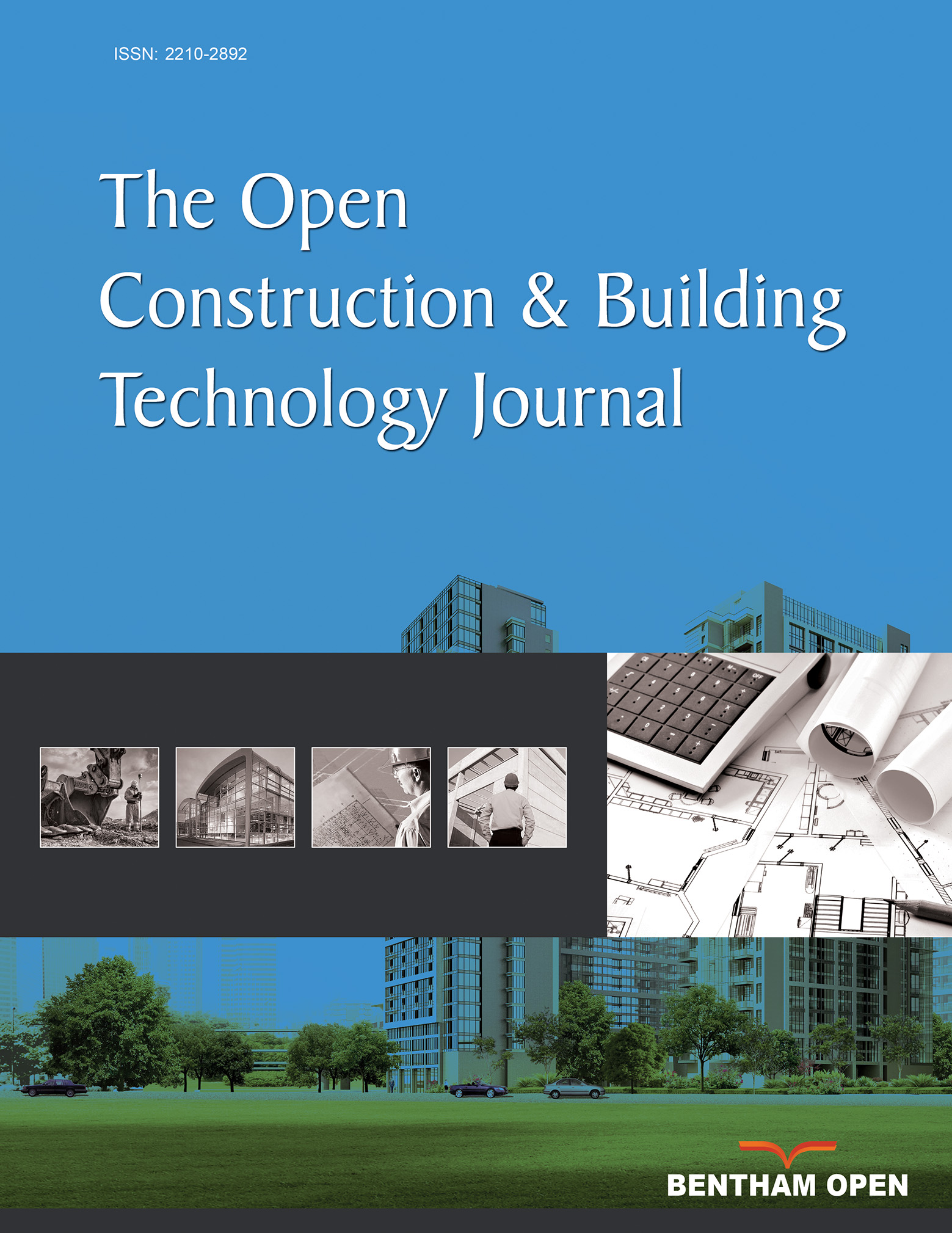All published articles of this journal are available on ScienceDirect.
Challenges and Barriers of Building Information Modeling Adoption in the Saudi Arabian Construction Industry
Abstract
Background:
The Building Information Modeling (BIM) revolution can provide a solution for problems in the Saudi Arabian construction industry and improve its outcomes. Though this technology is increasingly and rapidly adopted in advanced countries, developing countries such as Saudi Arabia and the Gulf Cooperation Council countries (GCC) are still in the early stages of BIM adoption.
Objective:
This study investigates the current state of BIM technology adoption by exploring and analyzing the critical challenges and barriers to BIM technology utilization in the construction sectors.
Methods:
The quantitative approach is adopted via a survey questionnaire distributed to participants in the field of construction projects in the Architecture, Engineering, and Construction (AEC) industry. A total of 228 questionnaires are collected and analyzed using the statistical packaging for social science software.
Results:
Findings show that several significant barriers negatively affect the utilization of BIM. The major barriers to BIM adoption are related to the lack of demand, lack of experts, and poor awareness of BIM benefits, which have relative importance indexes of (RII = 89.910), (RII = 88.475), and (RII = 87.130), respectively. Meanwhile, unspecified data responsibilities, difficulty of learning BIM, lack of data sharing, and sufficient current technology constitute the lowest-ranking barriers with their relative importance indexes of (RII = 71.704), (RII = 70.807), (RII = 66.413), and (RII = 65.874), respectively.
Conclusion:
The findings of this study are highly significant and can become more helpful and interesting if further research can measure the methodologies to implement BIM technology in the Kingdom of Saudi Arabia.
1. INTRODUCTION
The Kingdom of Saudi Arabia has one of the top 20 economies in the world and the largest economy in the Arab world and the Middle East [1]. The country has experienced a high level of economic growth; as a result, urban development excessively increased over the past few years [2]. Construction is one of the largest industries in Saudi Arabia and plays an important role in sustaining the economic growth and in improving people’s quality of life. The Kingdom’s construction market is expected to grow more than double and reach a record high of $96.52 billion in 2025 from $45.33 billion in 2016 [3]. Furthermore, the government has established its 2030 vision plan and encouraged all sectors to be creative, efficient, and environmentally responsible. A huge budget is dedicated to investments and encouragements in construction projects. However, the Saudi Arabian construction industry still faces critical problems such as poor planning, delays in project delivery, lack of communication, errors and changes in design, cash flow problems, and increased maintenance costs [4]. In 2017, the Ministry of Municipal and Rural Affairs [5] reported that approximately 75% of public construction projects have exceeded their planned time and are delayed [6].
As a new phenomenon, Building Information Modeling (BIM) technology can provide solutions for problems in the Saudi Arabian construction industry and improve its final outcomes. BIM is an advanced process and tools with combined virtual aspects, systems, and concepts facilitated within a unified environment [7]. The active role of this technology improves collaboration and communication among different project stakeholders. However, unfortunately, BIM implementation in Saudi Arabia has neither been made mandatory by the Saudi Arabian government nor has been widely adopted by construction organizations [8].
On such bases, investigating the current and the potential challenges of BIM technology utilization in Saudi Arabia is necessary. Therefore, this study expands the relevant literature to determine the scientific developments in the field. In the long term, this study can also certainly clarify further research to be developed and conducted on construction projects in Saudi Arabia.
2. LITERATURE REVIEW
BIM has become an essential part of the Architecture, Engineering, and Construction (AEC) industries in the world [9]. The successful implementation of BIM technology has allowed project stakeholders to capture its full advantages. BIM is considered a significant digital technology undergoing rapid growth in the construction industry for drawing, modeling, simulation, and management. This technology is recommended as the most effective tool in numerous advanced countries such as Australia, Singapore, Denmark, Norway, the United Kingdom, and the United States [10]. However, developing countries such as Saudi Arabia and those in the Middle East still face several limitations that hinder BIM integration [11].
The multiple benefits of BIM technology have been extensively studied [7, 12-16], including 3D visualization, cost estimation for all stages of the project, construction planning, clash detection, reduction of design errors and rework, enhanced project communication, and reduction of the overall project duration [17]. Though the significant benefits of solving most of the construction problems that planners, managers, designers, and other stakeholders face in the projects’ lifecycle stages, BIM implementation is also still subject to several challenges and limitations hindering its applications and slowing the implementation process.
Compiled from a comprehensive literature review of previous studies related to BIM through journal papers, books, articles, and websites, the barriers to BIM implementation are classified into 17, in some cases by including two or more sub-barriers within one barrier. The challenges and barriers are summarized in Table 1.
3. RESEARCH METHODOLOGY
3.1. Questionnaire Form Design
The questionnaire included two different types of questions: multiple choice and Likert scale. The first section of the questionnaire included general information about the respondents, such as nationality, place of work, academic qualification, engineering discipline, years of experience, working sector type, and job description. The second section focused on the background and awareness of BIM among the respondents. The third section included multiple five-point Likert-scale items that asked the respondents for their opinions on the barriers against BIM implementation using a scale from 1 (strongly disagree) to 5 (strongly agree) and 3 indicating a neutral attitude.
3.2. Pilot Study
A pilot study is a small initial study with respondents whose characteristics are similar to those of the original sample respondents [36]. Such study shows whether the questionnaire is proper for distribution to the target population [37]. S. J. Thomas [38] believed that approximately 30–50 respondents are sufficient for a pilot study. In the current study, 40 questionnaires were collected and analyzed.
3.2.1. Statistical Validity and Reliability
Validity and reliability tests were conducted on the data obtained from the pilot study.
3.2.2. Statistical Validity
This test determined the correlation coefficients between each particular item and the whole [39]. Table 2 shows the values of Pearson’s Rho correlation coefficient for BIM potential barriers.
3.2.3. Statistical Reliability
One of the most common ways to calculate the reliability of a questionnaire is through Cronbach’s Alpha coefficient [40]. On a scale from [0 to 1], a closer value to 1 indicates a higher degree of reliability. The Cronbach’s Alpha coefficient obtained from the pilot study was (0.851), which confirmed the reliability of the questionnaire. Table 3 shows the classification for the degree of reliability, according to Cronbach’s Alpha [36].
After the above validity and reliability tests on the results from the pilot study, the questionnaire was ready and eligible for distribution to the target sample [41].
3.3. Final Data Collection
The survey questionnaires were distributed using face-to-face, e-mail, and online websites tools to AEC industries. A total of 228 questionnaires were collected. After removing five uncompleted forms from the study, the total number of valid questionnaires used for the statistical analysis was 223 and the total response rate was (223/228) × (100) = 97.80%.
4. RESULTS AND DISCUSSION
The collected data were analyzed using the Statistical Packaging for Social Science (SPSS) software. The statistical analysis included descriptive statistics such as frequency, percentage, mean, and standard deviation. The relative importance index ranking (RII) for each item was also analyzed.
4.1. General Information for Respondents
Table 4 shows the engineering specializations and academic qualifications of the respondents, classified in two dimensions and illustrated in percentages in Figs. (1 and 2), respectively.
Respondents from the working sectors were classified into three categories, namely, Private, Public, and Public-Private sectors, as shown in Fig. (3). The majority of respondents were site and designer engineers, with percentages of 48.9% and 12.6%, respectively, as illustrated in Fig. (4).
| Reference | Barriers oF BIM Adoption | NO |
|---|---|---|
| [18, 19] | Construction market is not ready for BIM technology | B1 |
| [20-23] | Legal issues | B2 |
| [20-24] | High cost of BIM | B3 |
| [21, 22, 25] | Lack of government support | B4 |
| [24-26] | Lack of BIM training | B5 |
| [20-24] | Resistance to change | B6 |
| [20-24] | Poor awareness of BIM benefits | 7B |
| [27-29] | Sufficient current technology | B8 |
| [30, 31] | Difficulty of learning BIM | B9 |
| [20-25] | Lack of demand by owners | B10 |
| [24, 32] | Unspecified data responsibilities | B11 |
| [20, 21, 33] | Lack of BIM experts | B12 |
| [20, 25, 34] | Need for special BIM contracts | B13 |
| [32, 35] | Lack of support from top managers | B14 |
| [24, 32] | Lack of data sharing | B15 |
| [26, 32, 34] | Long time required for training the current employees | B16 |
| [20-23] | High cost of training current staff | B17 |
| Item | Correlation Coefficient | p-value | Item | Correlation Coefficient | p-value | Item | Correlation Coefficient | p-value |
|---|---|---|---|---|---|---|---|---|
| 1 | 0.478** | 0.000 | 7 | 0.464** | 0.000 | 13 | 0.340** | 0.002 |
| 2 | 0.581** | 0.000 | 8 | 0.360** | 0.003 | 14 | 0.475** | 0.002 |
| 3 | 0.425** | 0.001 | 9 | 0.404** | 0.001 | 15 | 0.509** | 0.001 |
| 4 | 0.468** | 0.000 | 10 | 0.412** | 0.001 | 16 | 0.347** | 0.004 |
| 5 | 0.406** | 0.001 | 11 | 0.474** | 0.000 | 17 | 0.358** | 0.003 |
| 6 | 0.379** | 0.002 | 12 | 0.405** | 0.000 | - | - | - |
*. Correlation is significant at the 0.05 level (2-tailed).
| Adequacy | Cronbach’s Alpha Value |
|---|---|
| Excellent | 0.9 and above |
| Good | 0.89- 0.8 |
| Acceptable | 0.79- 0.7 |
| Questionable | 0.69 0 - 0.6 |
| Poor | 0.59 and below |
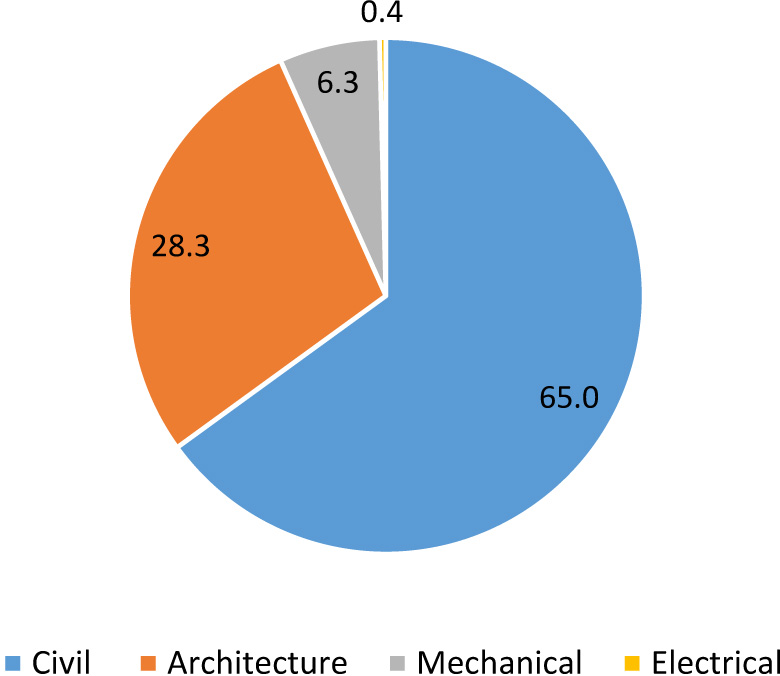
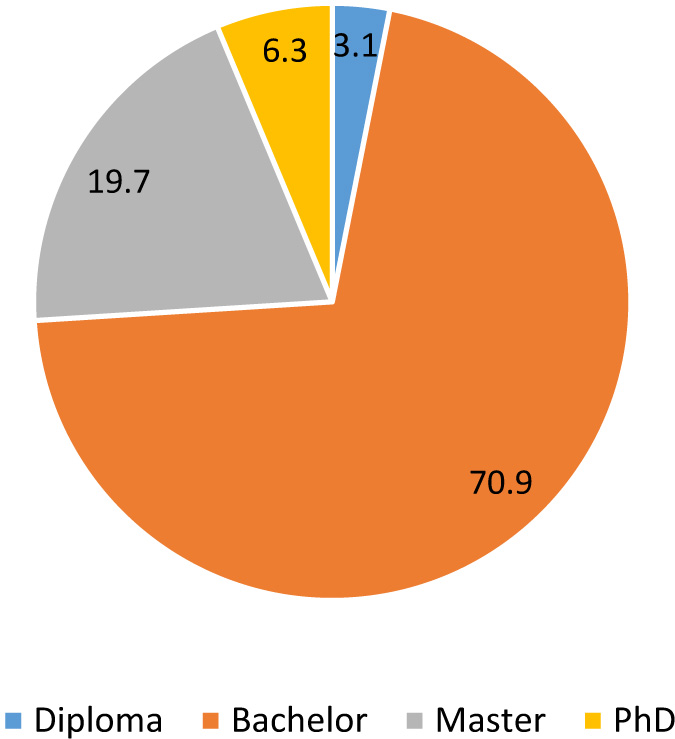
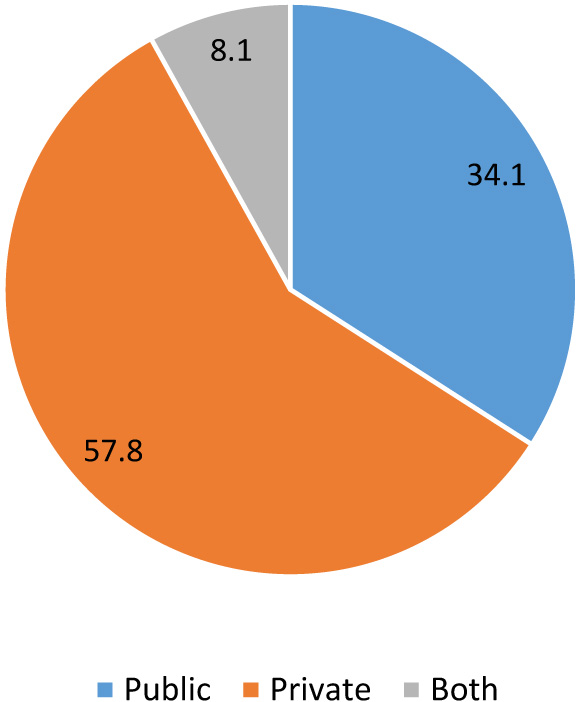
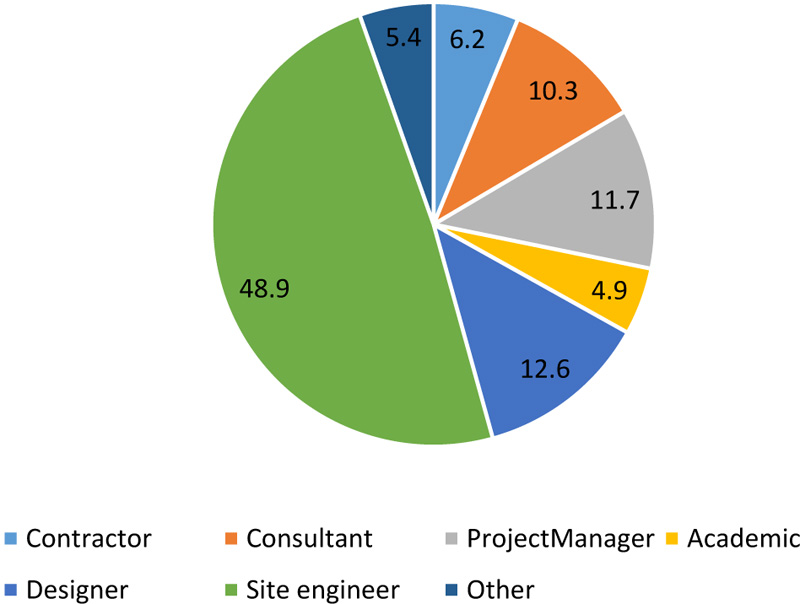
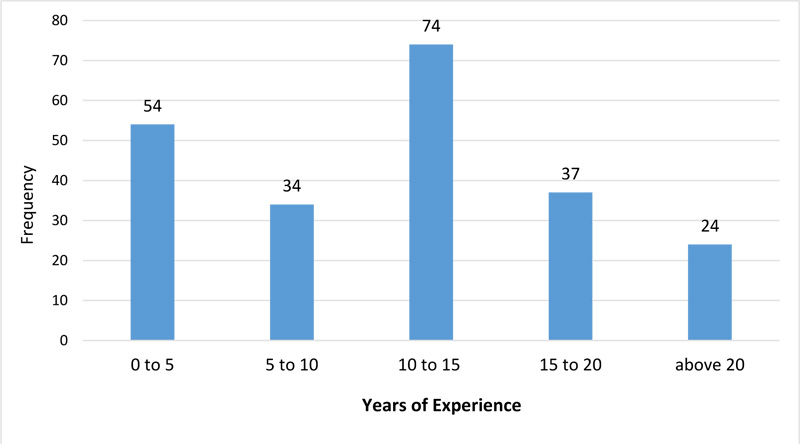
| Specializations Engineering | ||||||
|---|---|---|---|---|---|---|
| Academic Qualification | Civil | Architecture | Mechanical | Electrical | Total | |
| Diploma | 5 | 1 | 1 | 0 | 7 | |
| Bachelors | 110 | 37 | 10 | 1 | 158 | |
| Masters | 23 | 18 | 3 | 0 | 44 | |
| PhD | 7 | 7 | 0 | 0 | 14 | |
| Total | 145 | 63 | 14 | 1 | 223 | |
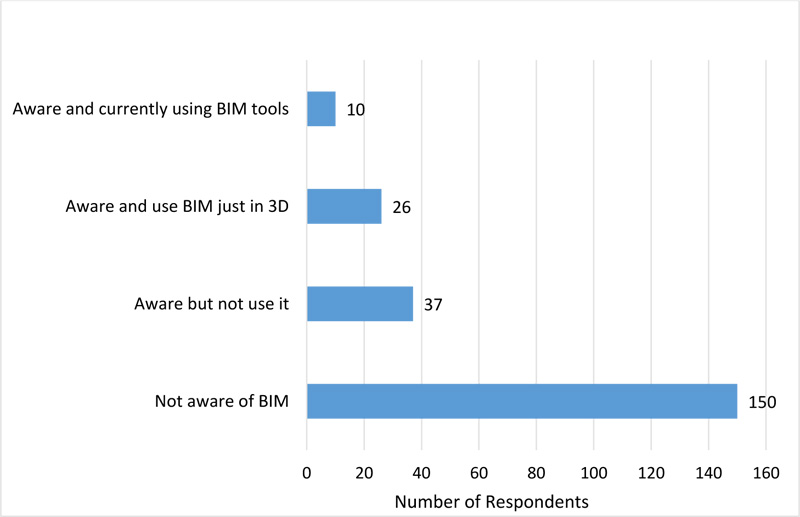

In terms of years of experience, majority (33.18%) of the overall respondents in this survey fell under the category [10-15] Years, while (24.22%) have less than five years’ experience in construction firms, see Fig. (5).
4.2. Current Practices and Level of BIM Awareness
In terms of BIM technology awareness, more than half of respondents (67.3%) in this survey were unaware of BIM. Only (4.5%) of overall respondents were aware of BIM usage and used it in practice, while (16.59%) of respondents were aware but had not used BIM, see Fig. (6). BIM awareness among the respondents is too low, which is consistent in previous findings [2]. The successful transition to using BIM in projects requires a major move away from traditional methods, which begins by providing training opportunities for the staff, a critical factor for successful BIM implementation [10].
4.3. BIM Knowledge in the Respondents’ Firms
The respondents were asked to state the general perception of the current level of BIM knowledge in their firms within a scale of five: No knowledge, Low knowledge, Medium knowledge, High knowledge, and Very high knowledge. Approximately (54.3%) of the respondents confirmed that their firms have no knowledge of BIM, while over (23.8%) believed that their firms have a little knowledge of BIM and less than (10.8%) believed that their firms have a medium knowledge of BIM. Only (6.3%) confirmed that their firms have an excessive knowledge of BIM. Fig. (7) shows the results [41].
| Rank | RII | Std. Deviation | Mean | Barriers of BIM Adoption | No |
|---|---|---|---|---|---|
| 15 | 66.413 | 0.830 | 1.82 | Lack of data sharing | B15 |
| 16 | 65.874 | 0.778 | 1.79 | Sufficient current technology | B8 |
| 9 | 74.484 | 1.144 | 2.22 | Construction market is not ready for BIM technology | B1 |
| 13 | 71.704 | 0.775 | 2.09 | Unspecified data responsibilities | B11 |
| 2 | 88.475 | 1.255 | 2.92 | Lack of BIM experts | B12 |
| 1 | 89.910 | 1.279 | 3.00 | Lack of demand by owners | B10 |
| 7 | 77.534 | 1.032 | 2.38 | Need for special BIM contracts | B13 |
| 14 | 70.807 | 1.063 | 2.04 | Difficulty of learning BIM | B9 |
| 12 | 72.601 | 1.137 | 2.13 | Long time required for training the current employees | B16 |
| 10 | 73.498 | 1.078 | 2.17 | Lack of BIM training | B5 |
| 4 | 87.040 | 1.193 | 2.85 | High cost of BIM | B3 |
| 4 | 87.040 | 1.193 | 2.85 | Lack of support from top managers | B14 |
| 5 | 81.031 | 1.133 | 2.55 | Resistance to change | B6 |
| 8 | 76.099 | 1.051 | 2.30 | Lack of government support | B4 |
| 11 | 73.049 | 0.946 | 2.15 | High cost of training current staff | B17 |
| 3 | 87.130 | 1.199 | 2.86 | Poor awareness of BIM benefits | B7 |
| 6 | 77.892 | 1.016 | 2.39 | Legal issues | B2 |
4.4. Relative Importance Index (RII)
RII was calculated by summing the score of each item on a scale from (1-5) and the corresponding frequency of response, then dividing this value by the total number of responses. The mean score and standard deviation value of each factor were also calculated and ranked, as shown in Table 5.
The “Lack of demand by owners” constituted the largest value (RII = 89.910), in agreement with [12]. The second barrier was “Lack of experts” with (RII = 88.475), followed by “Poor awareness of BIM benefits” in third with (RII = 87.130). This result is consistent with T. Almuntaser et al. [13]. The “High cost of BIM” and “Lack of support from top managers” scored the same ranking with (RII = 87.040). “Resistance to change” came in fifth with (RII = 81.031), in agreement with overseas studies S. Ahmed [9] and Y. Zhou et al. [27]. Legal issues ranked in sixth place with (RII = 77.892). The “Need for special BIM contracts” and “Lack of government support” recorded (RII = 77.534) and (RII = 76.099), respectively. “Construction market is not ready for BIM technology” recorded (RII = 74.484), whereas “Lack of BIM training” and “High cost of training current staff” had (RII = 73.498) and (RII = 73.049), respectively. The latter is an expected result due to the weakness of related training in universities and government centers. The lowest-ranking factors were “Unspecified data responsibilities”, “Difficulty of learning BIM”, “Lack of data sharing”, and “Sufficient current technology” with (RII = 71.704), (RII = 70.807), (RII = 66.413), and (RII = 65.874), respectively.
CONCLUSION
This study successfully investigated the critical challenges and barriers to BIM technology implementation. The results showed that “ Lack of demand by owners” ranked first among the barriers. The second barrier was “Lack of experts”, while “Poor awareness of BIM benefits” came in third. On the other hand, the lowest-ranking barriers were “Unspecified data responsibilities”, “Difficulty of learning BIM”, “Lack of data sharing”, and “Sufficient current technology”. To increase the level of awareness and knowledge in BIM, government centers and universities in Saudi Arabia must play an important role by providing training programs and workshops, and strongly encourage researchers and professionals in related fields to achieve better integration of BIM technology into the construction industry.
CONSENT FOR PUBLICATION
Not applicable.
AVAILABILITY OF DATA AND MATERIALS
The data used to support the findings of this study are included in the article.
FUNDING
The study was approved by the National Natural Science Foundation of China (Grant nos. 51379015 and 51579013) and the Fundamental Research Funds for the Central Universities, CHD (Grant no. 300102289303).
CONFLICT OF INTEREST
The authors declare no conflict of interest, financial or otherwise.
ACKNOWLEDGEMENTS
Declared none.

